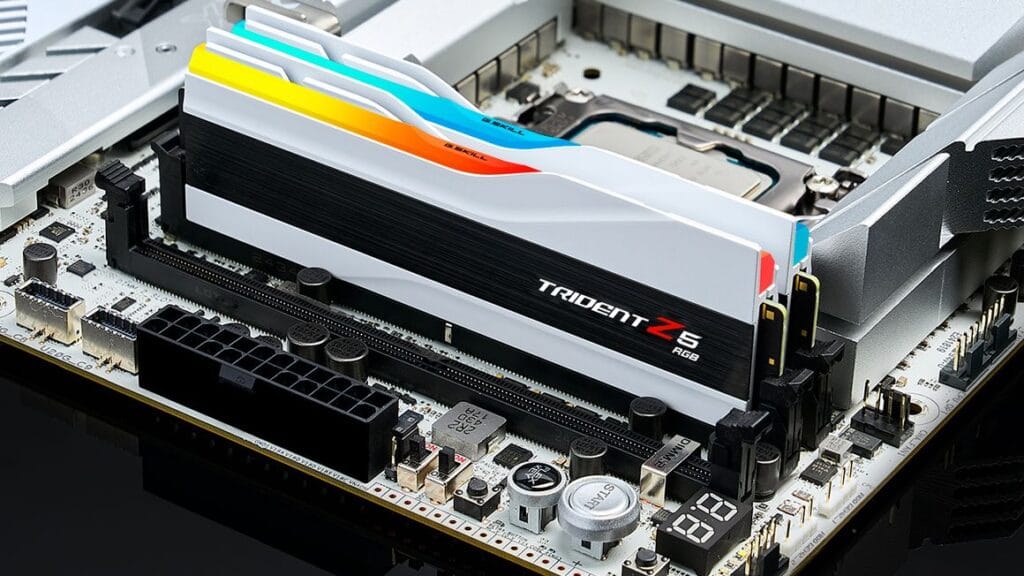G.Skill has set a new DDR5 RAM overclocking record with some of its memory in an Asus ROG motherboard, hitting a jaw-loosening speed of 12,112MT/s.
The feat was achieved by professional overclocker Safedisk, using G.Skill Trident Z5 RGB DDR5 memory in an Asus ROG Maximus Z890 Apex motherboard (with a new Intel Core Ultra 9 285K flagship desktop CPU).
To blaze the RAM over that 12,000MT/s mark, you won’t be surprised to learn that exotic cooling was necessary – in this case liquid nitrogen.
This is a new world record overclock for memory frequency as recorded by HWBOT, and it’s another in a fresh set of overclocking achievements which have been ushered in by Intel’s new Arrow Lake, Core Ultra 200S, family of processors.
Analysis: Overclocking potential
Far from everything about the launch of Intel’s Arrow Lake chips has been rosy, but there are certainly performance highlights with the new desktop family – gaming aside – and indeed plenty of overclocking potential with the new Z890 motherboards and Core Ultra 200 CPUs (the initial releases of which are unlocked ‘K’ models).
We’ve seen a record overclock of 7.5GHz for the Core Ultra 9 285K processor, the work of another expert overclocker, Elmor (backed by a team, again at Asus, achieved using the same ROG Maximus Z890 Apex motherboard that we see here).
As for the previous DDR5 record, that was set four days back by Kovan Yang (with Kingston RAM, in an Arrow Lake PC with an MSI MEG Z890 Unify-X motherboard), and this new record pipped it by a couple of Megahertz. There’ll doubtless be an ongoing tussle for a bit mileage as more professional overclockers try their hands with Intel’s Core Ultra 200S platform.
{ window.reliablePageLoad.then(() => { var componentContainer = document.querySelector(“#slice-container-newsletterForm-articleInbodyContent-tjDCB2cNswHfKj9xysMfP7”); if (componentContainer) { var data = {“layout”:”inbodyContent”,”header”:”Get daily insight, inspiration and deals in your inbox”,”tagline”:”Sign up for breaking news, reviews, opinion, top tech deals, and more.”,”formFooterText”:”By submitting your information you agree to the Terms & Conditions and Privacy Policy and are aged 16 or over.”,”successMessage”:{“body”:”Thank you for signing up. You will receive a confirmation email shortly.”},”failureMessage”:”There was a problem. Please refresh the page and try again.”,”method”:”POST”,”inputs”:[{“type”:”hidden”,”name”:”NAME”},{“type”:”email”,”name”:”MAIL”,”placeholder”:”Your Email Address”,”required”:true},{“type”:”hidden”,”name”:”NEWSLETTER_CODE”,”value”:”XTR-D”},{“type”:”hidden”,”name”:”LANG”,”value”:”EN”},{“type”:”hidden”,”name”:”SOURCE”,”value”:”60″},{“type”:”hidden”,”name”:”COUNTRY”},{“type”:”checkbox”,”name”:”CONTACT_OTHER_BRANDS”,”label”:{“text”:”Contact me with news and offers from other Future brands”}},{“type”:”checkbox”,”name”:”CONTACT_PARTNERS”,”label”:{“text”:”Receive email from us on behalf of our trusted partners or sponsors”}},{“type”:”submit”,”value”:”Sign me up”,”required”:true}],”endpoint”:”https://newsletter-subscribe.futureplc.com/v2/submission/submit”,”analytics”:[{“analyticsType”:”widgetViewed”}],”ariaLabels”:{}}; var triggerHydrate = function() { window.sliceComponents.newsletterForm.hydrate(data, componentContainer); } if (window.lazyObserveElement) { window.lazyObserveElement(componentContainer, triggerHydrate); } else { triggerHydrate(); } } }).catch(err => console.error(‘%c FTE ‘,’background: #9306F9; color: #ffffff’,’Hydration Script has failed for newsletterForm-articleInbodyContent-tjDCB2cNswHfKj9xysMfP7 Slice’, err)); }).catch(err => console.error(‘%c FTE ‘,’background: #9306F9; color: #ffffff’,’Externals script failed to load’, err)); ]]>
Sign up for breaking news, reviews, opinion, top tech deals, and more.
Naturally, you won’t ever see speeds like 12,000MT/s in the real world – they can only be reached in short bursts with exotic cooling systems as noted – but DDR5 RAM is very fast in terms of real-world overclocking too.
A recent innovation in the memory world is CUDIMMs, which are memory modules which have their own clock driver, as opposed to relying on the system clock like traditional DIMMS – and this leads to better stability and overclocks. We’ve seen this system with V-color RAM sticks which were pushed to hit 9200MT/s, no liquid nitrogen required. Impressive.





